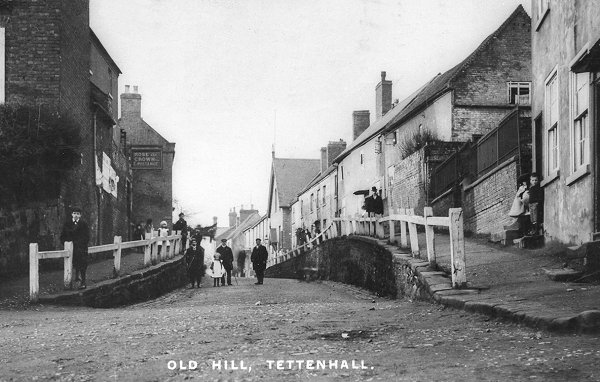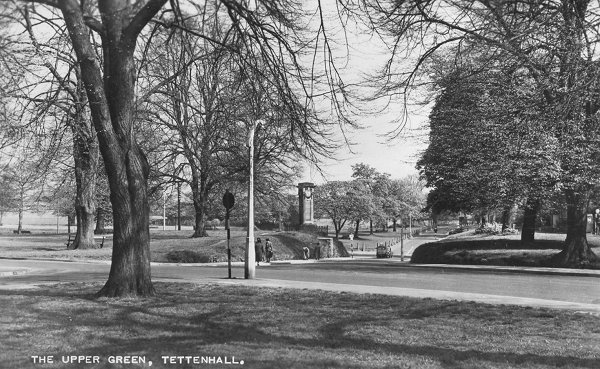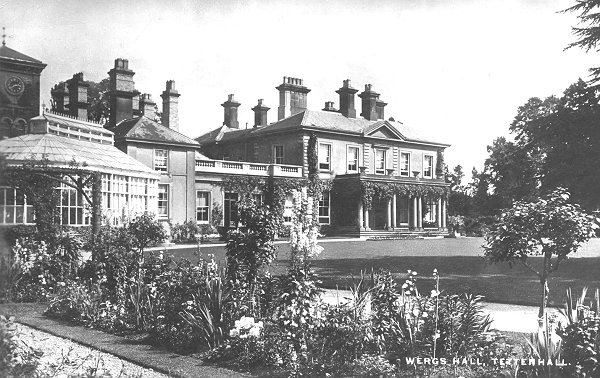|
A
description of Tettenhall from William White’s “History,
Gazetteer, and Directory of Staffordshire” published in 1851
Tettenhall, or Tettenhall Regis and
Clericorum, is a large and fertile parish, extending from
two to five miles W.N.W. of Wolverhampton, and comprising
3,143 inhabitants, and 7,965 acres of land, including the
villages, etc., of Tettenhall and Tettenhall Wood, Compton
Liberty, and the Prebends of Perton with Trescott, Bonevhill,
Pendeford, and Wrottesley; in which are several hamlets, and
many neat houses and villas. |
 |
Lord Wrottesley is lord of the manor of
Tettenhall Clericorum, including Perton and Wrottesley
prebends, and forming the west side of the parish; and W. F.
Fryer, Esq., and others, are joint lords of the manor of
Tettenhall Regis, which comprises the other two prebends.
Tettenhall Wood forms part of J. H. H. Foley, Esqr.’s manor
of Kinver, and was enclosed in 1809.
Here are a number of
other freeholders, the largest of whom are Miss Hinckes, and
T. H. Pearson, George Holyoake, William Grainger, T. S.
Hellier, and Thomas Fowler, Esqrs.
Tettenhall village stands near the
centre of the parish, two miles W.N.W. of Wolverhampton, and
comprises many respectable houses on and near the Shifnal
road, at the foot, and on the declivities of a lofty and
picturesque eminence, which rises above the Smestow rivulet,
and the Staffordshire and Worcestershire Canal.
The houses
are occupied chiefly by gentry, and by persons engaged in
the trade and commerce of Wolverhampton. |
|
Before the Norman conquest the village
was called Theotenhall, signifying the house of the pagans.
In 910, a severe battle was fought here, between the Danes
and Edward the Elder, and the ashes of the slain are
supposed to rest under a tumulus in Lowhill field.
Wolverhampton water works, are on the Upper Green, above the
village. The water works, which now supply a
great part of the town with the pure beverage of nature,
were constructed by a company of proprietors, holding 2,600
£10 shares, under the powers of an Act of Parliament
obtained in 1845. They were so far complete in August, 1850,
that they supplied 2,700 houses for the annual rental of
about £2,200.
The Company is now greatly extending the
works, under the powers of a new act, obtained in 1850, for
the purpose of enabling them to increase their capital by
the creation of 2,600 new shares of £10 each; and to extend
their works so as to be able to supply, not only the
inhabitants of Wolverhampton, but those of Bilston,
Willenhall, Wednesfield, Sedgley, etc. The present source is
at Upper Green, Tettenhall, in an immense well, which has
been sunk through the sandstone rock to the depth of 140
feet, and has at the bottom an excavation capable of holding
more than 300,000 gallons. Two steam-engines, equal to the
power of 100 horses, are employed in pumping the water from
this well to the summit of a tower 180 feet high, whence it
is sent in pipes to the houses of the customers.
The works at Tettenhall were designed
by Mr. Thomas Wicksteed, of London. For a supply of water the smallest houses
are charged 7s. per annum, and houses let for £10 a year are
charged 12s. Large houses pay about five per cent on their
rental, which is not a very equitable scale, as many houses
of £100 rental may not use more water than others of half
that value. Baths are charged 10s., and horses 7s.6d. per
annum. Mr. H. Marten is the engineer, and Mr. W. C. Bromby
is clerk and collector. The office is at 21 Snow Hill. Fire
plugs are placed at convenient distances in the public
streets, and there are in the town several powerful fire
engines belonging to the town and the Birmingham and County
Fire Offices. |

|
On the village green was a fine grove
of elms, planted nearly 150 years ago, but twelve of them
were torn up by the roots, during a dreadful storm of wind,
on January 7th, 1839.
Tettenhall Wake is on the first Sunday
and Monday after Old Michaelmas day. The church, dedicated
to St. Michael, was a royal free chapel, and enjoyed all the
privileges of such peculiars. It was anciently collegiate.
The college was founded previous to the Norman conquest, and
had a dean, and five prebendaries, till the period of its
dissolution in the reign of HenryVIII.
The present church is
supposed to be part of the original foundation, but it was
enlarged in 1825, so as to make room for 382 additional
sittings; and was re-pewed in 1841 when the five old bells
(dated 1604) gave place to a new peal of eight. It now has
1030 sittings, of which about 200 are free. The font is
curiously ornamented with Gothic sculpture; and in the
vestry is a valuable oak chest, 13½ feet long, hewn out of a
solid block, and strongly plated with iron. The perpetual
curacy, valued at £196, is in the patronage of Lord
Wrottesley, and incumbency of the Rev. Edward J. Wrottesley.
By an act of Parliament, in the 5th of Anne, and the gift of
“the several lords, owners, and tenants of the manor of
Tettenhall Regis”, 48A. 3R. 12P. of land on Kingswood Common
was allotted for the support of the incumbent minister of
Tettenhall, together with a house and garden for his
residence. The incumbent has also £5.5s. yearly, from an
acre of land adjoining his garden, purchased with £210
received for land taken for a new turnpike, and for a right
of road over the glebe land. |

|
Benefactions
The proceeds of six
charities, amounting to £56.7s.4½d. per annum, are
distributed in the vestry on Good Friday and St. Thomas’
day, among the poor nor receiving parochial relief, in sums
of 2s.6d. and 3s each. Of this yearly income, £13.11s.
arises from land at Albrighton, purchased in 1630 with £60
given by Walter Wrottesley, Esq., and others; £19.6s.4½d.
from Byrch House and land, purchased in 1714, with £115, the
amount of several benefactions; £5 from land at Salt Moor,
near Wolverhampton, left by Thomas and Ann Croffts, in 1709;
£16.10s. from High Bagridge close, (11A. 26P.) near
Wightwick, purchased in 1714, with £115 left by Henrietta
Wrottesley and William Smith; and £2 from the benefactions
of Mary Dobson and Matthew Wightwick.
Two shillings worth of bread is
distributed every Sunday, from the bequests of Sir John and
William Wollaston, out of land at Trescott, belonging to
Lord Wrottesley. The poor also have the interest of three
other benefactions; viz., £20 left by Eliz. Russell, in
1757; £100, three percent reduced annuities, by Lady
Wrottesley; and £60 by William and Richard Smith; but part
of the latter sum was expended in enlarging the workhouse in
1787, together with £50 left by Dorothy Fowler, who directed
the interest to be distributed yearly in bibles, prayer
books, and “The Whole Duty of Man”, amongst the poor boys
and girls of the parish. |

|
In 1827 Phoebe Rogers left £40, and
directed one half of the interest to be divided among 20
poor parishioners, and the other to be paid to the master of
the National School, built in that year by subscription and
a grant from the Central School Society. This school is
supported by voluntary contributions, for the education of
about 130 children of both sexes.
The Wesleyans have a
chapel and school in the village, built in 1825. The parish
is assessed at the annual value of £20,782. Richard Cresswell, Esq., in 1707, settled six almshouses which he
had built, for the residence of six poor parishioners, and
endowed them with £5 each per annum, to be paid for ever out
of his estate at Bilbrook. For many years the persons who
received this rent-charge of £30, resided at a distance, and
let the almshouses (which now consists of only four
cottages,) at £1 a year each. About 62 years ago, owing to
the non-appointment of new trustees, the application of the
annuities became irregular, and at length entirely ceased,
so that in 1821, Mr. John Parker, then owner of the estate,
owed to the charity an arrear of £453, which he said he was
ready to pay to the heir of the surviving trustee, as soon
as he should be ascertained, provided the annuitants were
suffered to reside in the almshouses, as required by the
founder’s will. The state now belongs to Mr. W. Smith.
|
 |
|
 |
Return to
Contents |
|
Proceed to
directory |
|